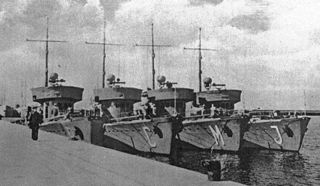
In naval terminology, a destroyer is a fast, maneuverable, long-endurance warship intended to escort larger vessels in a fleet, convoy, or carrier battle group and defend them against a wide range of general threats. They were originally conceived in 1885 by Fernando Villaamil for the Spanish Navy as a defense against torpedo boats, and by the time of the Russo-Japanese War in 1904, these "torpedo boat destroyers" (TBDs) were "large, swift, and powerfully armed torpedo boats designed to destroy other torpedo boats". Although the term "destroyer" had been used interchangeably with "TBD" and "torpedo boat destroyer" by navies since 1892, the term "torpedo boat destroyer" had been generally shortened to simply "destroyer" by nearly all navies by the First World War.

ORP Błyskawica (Lightning) is a Grom-class destroyer which served in the Polish Navy during World War II. She is the only Polish Navy ship to have been decorated with the Virtuti Militari, Poland's highest military order for gallantry, and in 2012 was given the Pro Memoria Medal. Błyskawica is preserved as a museum ship in Gdynia and is the oldest preserved destroyer in the world. Błyskawica is moored next to the Dar Pomorza.

The Grom-class destroyers were two destroyers, built for the Polish Navy by the British company of J. Samuel White, Cowes. They were laid down in 1935 and commissioned in 1937. The two Groms were some of the fastest and most heavily armed destroyers of World War II.

ORP Grom was the lead ship of her class of destroyers serving in the Polish Navy during World War II. She was named after the Polish word for Thunderbolt, while her sister ship ORP Błyskawica translates to lightning.

ORP Grom is an Orkan-class fast attack craft. It is the sister ship of Orkan and Piorun.

ORP Piorun was an N-class destroyer operated by the Polish Navy in World War II. The word piorun is Polish for "Thunderbolt". Ordered by the Royal Navy in 1939, the ship was laid down as HMS Nerissa before being loaned to the Poles in October 1940 while still under construction.

ORP Burza was a Wicher-class destroyer of the Polish Navy which saw action in World War II.

ORP Orkan, formerly HMS Myrmidon, was an M-class destroyer of the Polish Navy during World War II. Orkan is Polish for "hurricane".

The Svetlana-class cruiser was the first class of light cruisers built for the Imperial Russian Navy (IRN) during the 1910s. Construction was interrupted by World War I, the Russian Revolution and the Russian Civil War. Only Svetlana of the quartet was completed by the Soviet Union as a cruiser, two were converted to oil tankers, and the remaining ship was scrapped without being completed.

The Wicher-class destroyers were a series of destroyers that served in the Polish Navy during World War II. Two ships of this class were built for the Second Polish Republic by Chantiers Navals Français during the late 1920s. They were modified versions of the Bourrasque-class destroyers built for the French Navy.
The German torpedo boats of World War II were armed principally, if not exclusively, with torpedoes and varied widely in size. They were not small schnellboote but small seagoing vessels, the larger of which were comparable to destroyers. During World War II, German torpedo boats were administratively grouped into several torpedo-boat flotillas.

The Vifor class was a group of four destroyers ordered by Romania in 1913 and built in Italy during the First World War. The four ships were however requisitioned by Italy in 1915 and rearmed as scout cruisers (esploratori), subsequently seeing service in World War I. Two were re-purchased by Romania in 1920 and saw service in World War II. The other two were eventually transferred by Italy to the Spanish Nationalists and saw service during the Spanish Civil War.
Three ships of the Polish Navy have been named ORP Orkan :

ORP Żuraw was a Jaskółka-class minesweeper of the Polish Navy at the outset of World War II. Her name is the Polish word for the common crane. Żuraw participated in the defense of Poland during the German invasion of 1939. The ship was surrendered to the Germans following the Polish capitulation and renamed Oxhöft as a naval trawler. Following the German surrender at the end of the war, the ship was returned to Poland under her old name. In 1947, Żuraw was modified for use as a hydrographical survey ship and renamed Kompas. She was broken up in 1981.

The Polish Navy is the naval branch of the Polish Armed Forces. The Polish Navy consists of 46 ships and about 12,000 commissioned and enlisted personnel. The traditional ship prefix in the Polish Navy is ORP.

The Orkan class or projekt 660 is series of three fast attack craft of the Polish Navy, in service since 1992.

ORP Orkan is an Orkan-class fast attack craft and sister ship of Grom and Piorun.

ORP Piorun is an Orkan-class fast attack craft and sister ship of Grom and Orkan.














